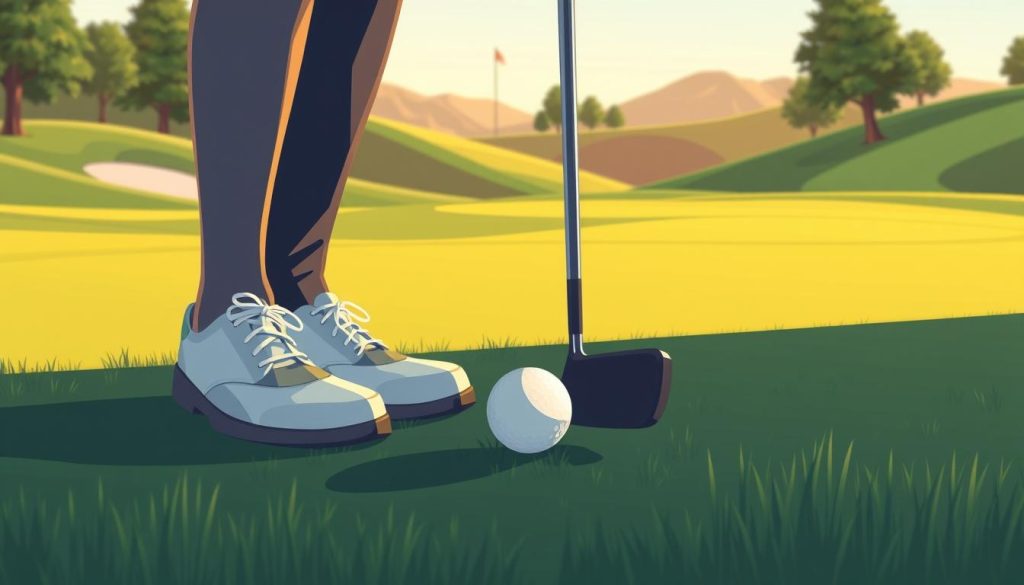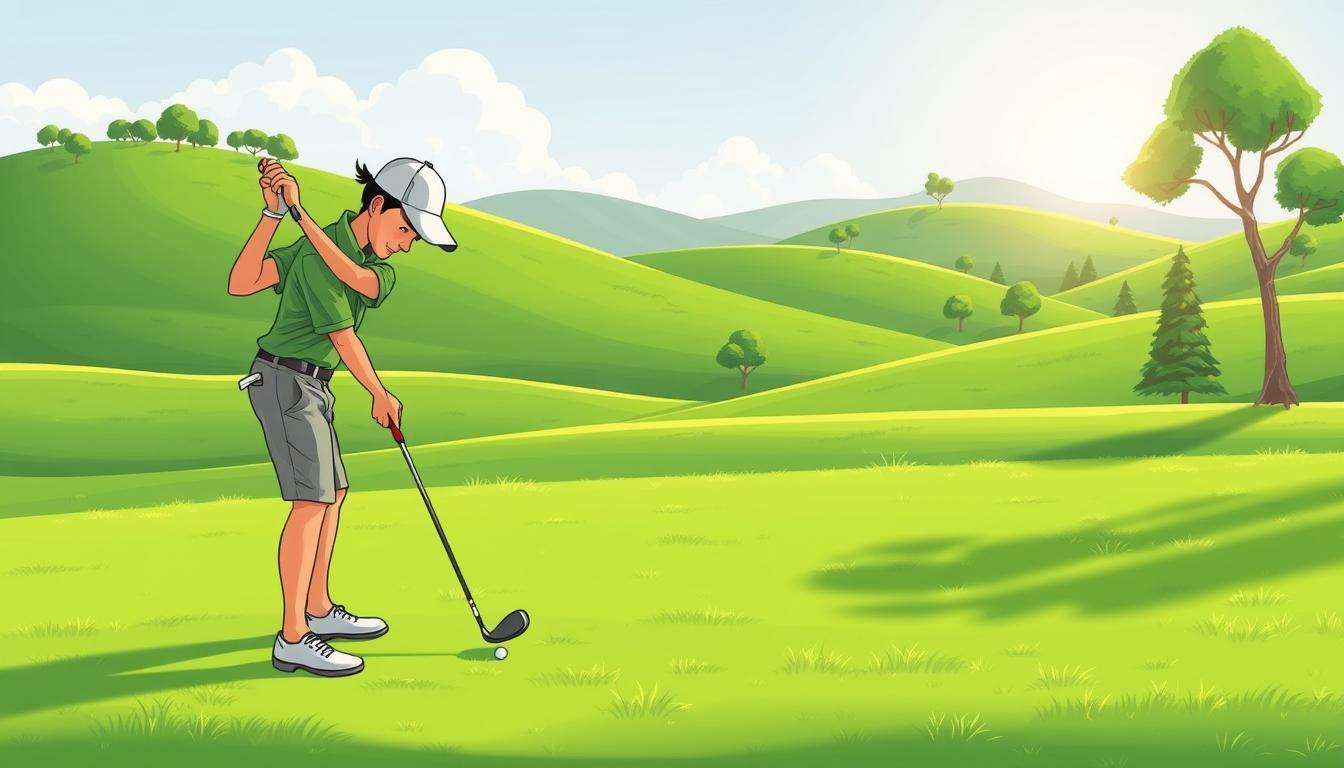Golf putting is all about precision and patience. This guide will teach you the art of putting. You’ll learn key techniques, how to read greens, and improve your stroke. With practice, you’ll get better at putting and lower your scores.
The perfect putt needs speed, aim, and stroke. To get it right, you must develop a good putting technique. You’ll also learn to read greens well and improve your stroke. This guide will cover everything from setting up to advanced training.
Key Takeaways
- Putting accounts for nearly half of all swings in golf (43%)
- A perfect putt combines speed, aim, and stroke
- Consistency is crucial for improving putting skills
- Green reading methods include Visual Inspection and AimPoint
- Proper setup, grip, and stroke mechanics are vital for success
- Regular practice with drills enhances putting performance
Understanding the Fundamentals of Putting
Learning the basics of putting is key to bettering your golf game. Putting makes up about 43% of all strokes in a round. It’s a skill you really need to get good at. Let’s explore the main points to help you get better at putting.
The Role of Consistency in Putting Success
Being consistent in your putting stroke is very important. A smooth motion helps you hit the ball more accurately and control its distance. To improve, keep your grip steady, your wrists firm, and your follow-through smooth.
Key Components of a Putting Stroke
A good putting stroke has four main parts: grip, stance, aim, and how you execute it. Your grip should feel right, letting you transfer energy well. Stand with your feet apart, knees bent, and weight balanced.
Align your body straight to the target line. Keep your head over the ball. This setup helps you aim better.
Understanding Green Reading Basics
Knowing how to read the green is crucial for making more putts. Look at the slope, grain, and shape of the green to guess where the ball will go. Remember, the angle of the putter face at impact matters a lot more than how you swing it.
Hit the ball from the center of the putter face with a square clubface. This will give you the best results.
By learning these putting basics, you’ll get better at your stroke and lower your scores on the green.
The Perfect Putting Setup Position
Mastering the perfect putting setup is key to improving your golf game. A good stance, ball position, and weight balance are essential. Let’s explore what makes up the ideal putting setup.
Your putting stance should be both comfortable and stable. Stand with your feet shoulder-width apart. This allows for a balanced posture. Make sure to distribute your weight evenly on the balls of your feet. This helps keep you stable throughout your stroke.
The ball position is crucial in your setup. Place the ball slightly forward of center in your stance. This neutral position helps you strike the ball smoothly and accurately.
Proper upper body positioning is vital for a consistent stroke. Bend slightly at the hips, keeping your back straight. Your arms should hang naturally, with a slight bend in your elbows. This posture helps you move like a pendulum during your stroke.
| Setup Element | Optimal Position | Common Mistake |
|---|---|---|
| Eye Position | Directly over the ball | Too far forward or back |
| Spine Angle | 113-123 degrees | Too upright or hunched |
| Right Arm Angle | 135 degrees or less | Over 151 degrees |
Your putter length should be comfortable for you. When gripping the putter, your arms should form a slight angle. This setup helps you move naturally and improves your putting consistency.
Mastering Wrist Control and Movement
Wrist control is key in putting. It greatly affects your putting stroke mechanics. Learning to manage your wrist movements can boost your putting accuracy and consistency.
Limiting Wrist Range Motion
Professional golfers aim to reduce wrist motion in their putting. By doing so, they gain better control and consistency. It’s important to keep your wrists stable, avoiding too much flexion or extension.
Natural Wrist Movement Patterns
While it’s good to limit wrist motion, some movement is needed. You should aim for a slight lead wrist extension (cupping) to add loft. Or, a subtle lead wrist flexion (bowing) to reduce loft. These small changes can help you strike the ball better and improve your putting.
Common Wrist Control Mistakes
Many amateur golfers face issues with wrist movement in putting. Some common mistakes include:
- Excessive radial deviation, which can cause you to lift the putter and strike the ball improperly
- Inconsistent rotation, leading to pushes or pulls in your putts
- Over-active wrists, resulting in a lack of stability at impact
To better your putting, practice keeping your wrists firm. Focus on consistent rotation patterns. Remember, the putter face affects 83% of the ball’s initial direction. So, mastering wrist control is crucial for accurate putts.
Putting Stroke Mastery Guide
Mastering your putting stroke is key to lowering scores and boosting confidence. This guide will help you improve your putting game. Putting accounts for nearly half of the strokes in a round, so improving here can make a big difference.
First, work on your setup position. A stable stance and proper alignment are crucial. Try different grip styles to find what works best for you. Consistency in grip pressure and hand position is important.
Wrist control is vital. Keep your wrist motion limited and natural. Avoid breaking your wrists, as it can cause inconsistent contact.

Tempo is also crucial. Aim for a 2:1 backswing to forward swing ratio. Using a metronome can help you develop this rhythm. As you get better, adjust your tempo for different distances while keeping your stroke smooth.
Face control and path mechanics are key for accurate putts. Practice drills to keep your putter face square and on the right path. Mirror practice can help you visualize and perfect your stroke.
| Aspect | Focus Area | Practice Method |
|---|---|---|
| Setup | Stance and Alignment | Alignment aids |
| Grip | Stability and Control | Experiment with styles |
| Wrist Control | Limited Range Motion | Pendulum drills |
| Tempo | 2:1 Ratio | Metronome training |
| Face Control | Square at Impact | Gate drills |
By adding these elements to your practice, you’ll improve your putting stroke. Remember, consistent practice and visualization are essential for skill improvement and better performance on the greens.
The Science of Putting Tempo
Putting tempo is key in golf. It’s the rhythm that guides your stroke. This rhythm helps you sink more putts and lower your scores. Let’s explore the science behind this important aspect of putting.
The 2:1 Tempo Ratio Explained
Top golfers use a 2:1 tempo ratio in their putting strokes. This means the downswing is twice as fast as the backswing. This ratio helps keep accuracy across different putt lengths. By focusing on this rhythm, you can improve your putting consistency and accuracy.
Using Metronome Training
Golf metronome training helps develop a steady putting tempo. Studies show a pace of 72 to 80 beats per minute works best for most golfers. Start by setting your metronome to this range and practice syncing your strokes to the beat. This method can help make a consistent tempo a part of your muscle memory.
Adapting Tempo for Different Distances
While the 2:1 ratio stays the same, you’ll need to adjust your tempo for different putt lengths. For longer putts, slow down your entire stroke while keeping the ratio. For shorter putts, speed up the overall tempo. Practice this to improve your distance control and putting accuracy across the green.
- Short putts: Quicker overall tempo
- Medium putts: Moderate tempo
- Long putts: Slower overall tempo
Remember, mastering putting tempo takes time and practice. Use these techniques to refine your stroke. Watch your putting performance improve on the course.
Face Control and Path Mechanics
Mastering putter face control and putting path is key to sinking more putts. Your skill in these areas can greatly impact your game. Let’s explore the mechanics to boost your putting.
Understanding your grip is the first step in putter face control. A strong grip helps close the clubface, while a weak one keeps it open. Try different grips to find your best fit. Consistency is crucial.
Your putting path affects the ball’s direction. Many think the “straight back, straight through” method is best, but a slight arc is often needed. Experiment with paths like out-to-in and in-to-out to see their effects.
Try the Meter Stick Distance Control drill to improve. It helps with distance and speed control. Spend 5 minutes on the green to practice standard distances.
- Inner Thigh = 6 paces
- Outer Thigh = 9 paces
- Pocket = 12 paces
Use body landmarks for different putt lengths. Add distance for uphill or against-the-grain putts. Subtract for downhill or with-the-grain ones. With practice, you’ll lag putt confidently from 40 feet.
Technology can help you improve. Tools like HackMotion give feedback on wrist movements. This helps control the clubface better. Top players keep their lead wrist flat or slightly flexed at the top and impact.
Work on forearm rotation for better control and power. Focus on lead wrist flexion at impact for straight shots. With practice, you’ll master putter face control and path mechanics.
Grip Techniques for Consistent Putting
Mastering putting grip techniques is key for consistent golf. The right grip can greatly improve your putting. Let’s look at popular grip styles and how to manage grip pressure for better performance.
Popular Grip Styles
Many effective putting grip techniques are used by pros and amateurs. Each style has its own benefits:
- Conventional (Reverse Overlap): Used by Tiger Woods and Rory McIlroy
- Left-Hand Low: Helps square shoulders at address
- Claw: Reduces wrist movement
- Prayer: Promotes a pendulum-like stroke
- Arm Lock: Anchors the putter against the forearm
Grip Pressure Management
Getting the right grip pressure is crucial for putting success. A light grip helps with feel, while a firmer grip improves accuracy. Find a pressure that feels secure yet relaxed.
Hand Position Consistency
Keeping hands in the same position on the putter is vital. Practice your chosen grip style often. Use indoor putting mats to improve your technique. Also, consider the grip thickness – thicker grips can help with accuracy, while thinner ones enhance feel.
| Grip Style | Best For | Notable Users |
|---|---|---|
| Conventional | All-round use | Tiger Woods, Rory McIlroy |
| Left-Hand Low | Reducing wrist action | Jordan Spieth |
| Claw | Smoother stroke | Tommy Fleetwood |
| Prayer | Pendulum-like motion | Matt Kuchar |
| Arm Lock | Stability | Bryson DeChambeau |
The best putting grip is one that feels comfortable. It should promote a synchronized movement of your hands, shoulders, and putter. Try different styles to find what works best for you and stick with it for consistent golf.
Distance Control and Speed Management
Mastering putting distance control and speed management is key to lowering your golf scores. Golfers who get this right often outperform others, reducing three-putts and boosting confidence.
Uphill putts need a bit more power to fight gravity. Downhill putts should be seen as shorter for better speed control. Knowing how slopes change is crucial. High-quality putters, like the Pyramid iCOR, help adjust for these changes, leading to more accurate putts.

Consistent rhythm and controlled pace are secrets to successful long-distance putts. Regular practice improves accuracy and boosts confidence. Studies show right-handed golfers do well with right-to-left putts, showing the importance of knowing your strengths.
Green reading, often ignored by lower to mid handicap players, is vital for speed management. Spotting gentle slopes of 1-2 degrees can greatly improve your putting.
| Putting Aspect | Impact on Performance |
|---|---|
| Consistent rhythm | Improves long-distance putts |
| Regular practice | Enhances accuracy, reduces three-putts |
| Green reading skill | Crucial for proper speed management |
| Slope understanding | Affects putt direction and speed |
To better your putting, consider using tools like FinalPutt’s Putting Bundle. This set includes a Putting Ruler, Pro Tutor, and Putting Template. It’s designed to improve start line accuracy, stroke consistency, and alignment.
Advanced Training Methods and Drills
Boost your putting skills with these advanced training methods and drills. Use golf training aids and special techniques to see big improvements in your game.
Path Length Training
Work on your stroke length and tempo with the tee drill. Place two tees on the green, marking your backswing and follow-through. Swing your putter between these points to build muscle memory for a consistent path length.
Mirror Practice Techniques
Use a mirror to improve your putting mechanics. Set up a full-length mirror next to your stance. This visual feedback helps you spot and correct posture, alignment, and stroke path issues. It’s a great way to keep your form right.
Alignment Drills
Enhance your aim and setup with the gate drill. Place two tees slightly wider than your putter head a few feet in front of the ball. Practice putting through this “gate” to fine-tune your alignment and stroke path. Gradually increase the distance to challenge yourself.
Add these advanced putting drills to your practice routine. Use golf training aids like alignment sticks or putting mats to boost your sessions. Remember, consistency is key. Regular practice with these methods will lead to noticeable improvements on the green.
Conclusion
Mastering your putting stroke is key to improving in golf. Focus on wrist control, tempo, and grip consistency. These tips from pros like Brad Faxon can help a lot.
Getting your putter fitted to your body is also important. Think about length, head design, and grip size. A standard 35-inch putter might not fit everyone. Taller golfers might need a longer one, while shorter ones might need a shorter one.
Practice is essential for better putting. Use training aids, visualization, and drills to improve. Make sure your grip is finger-based and your arm is relaxed. With consistent practice, you’ll get better at putting and improve your golf game.
FAQ
What are the key components of an effective putting stroke?
How important is green reading in putting?
What is the ideal setup position for putting?
Why is limiting wrist motion important in putting?
What is the optimal tempo for putting?
How can I improve my face control in putting?
What are some effective grip techniques for consistent putting?
How can I improve my distance control in putting?
What are some advanced training methods for putting?
How can neuroplasticity training benefit stroke recovery?
Source Links
- https://skillest.com/blog/master-the-art-of-golf-putting-a-comprehensive-guide-for-beginners/
- https://www.pgaplay.co.uk/learn/the-definitive-guide-to-mastering-the-art-of-putting/
- https://pelzgolf.com/product/dave-pelzs-putting-bible-the-complete-guide-to-mastering-the-green-dave-pelz-scoring-game-series/
- https://golf-upgrades.com/blogs/golf-upgrades-blog/fundamentals-of-a-putting-stroke?srsltid=AfmBOooNQWtDl2faIsXGzsbCLbWv9TLq7yWqxlE9rXr1Uu7NW0YgpqS-
- https://golf.com/instruction/dave-pelzs-10-truths-about-putting/
- https://www.three-20.com/putting-fundamentals
- https://golfpartnerusa.com/blogs/club-reviews/mastering-the-art-of-putting-a-comprehensive-guide-to-setup-and-technique?srsltid=AfmBOoqLCfuzHoivWP2QZT1ZcG1TNyD_RwpCnjSd9H29d1aEu0b8loGA
- https://hackmotion.com/putting-stroke-tips/
- https://sportsedtv.com/blog/master-your-putting-setup-a-simple-drill-for-precision-and-consistency
- https://hackmotion.com/wrist-action-in-putting/
- https://www.elitegolfacademies.com/blog-articles/putting-mastery-series-01-unlocking-the-secrets-of-putting-setup-fundamentals
- https://www.golfzongolf.com/blog/technology/the-art-of-putting-in-golf-a-comprehensive-guide
- https://patch.com/pennsylvania/doylestown/mastering-art-putting-guide-lower-scores
- https://www.golfzonleadbetter.com/blogs/master-your-putting-game-6-effective-putting-drills-for-precision-speed-alignment/
- https://us.humankinetics.com/blogs/excerpt/putting-techniques?srsltid=AfmBOorRQEluBfd8mxpipFY8td1G1fMHd-kpijSsrALpoK61pXrbKNEb
- https://www.golfsmartacademy.com/golf-instruction/length-of-back-swing/
- https://hackmotion.com/master-clubface-control/
- https://primeputt.com/blogs/golf/putting-grip-styles?srsltid=AfmBOorEr4lDyuzL8bgVBcKAU6swljBZ-3tBlNKh7L-3yOLfeXm9H3RV
- https://golf.com/instruction/putting/putting-grips-guide-jim-murphy/
- https://superiorgolf.blog/uphill-and-downhill-putts/
- https://hackmotion.com/best-putting-tips/
- https://finalputt.com/blogs/how-to-break-80/the-best-putting-aids-to-lower-your-score?srsltid=AfmBOopEaLMX1k2Mz2gRoBC0B2gWMpiL3t–npRCtTGzIBHKPoxf2cYg
- https://www.performforgolf.com/blog/how-to-put-better-the-best-putting-drills
- https://justgolfstuff.ca/blogs/guide/how-to-put?srsltid=AfmBOortSyooe0Ggdro4ob4wvz0eAbMBbSrt59-5lVKWWIR12Eb3tg7K
- https://skillest.com/blog/putting-like-brad-faxon-tips-to-improve-your-putting-stroke/
- https://skillest.com/blog/a-comprehensive-guide-to-mastering-the-golf-swing/
- https://www.thegolfshoponline.co.uk/blog/what-length-of-putter-do-i-need/?srsltid=AfmBOooiP6oIzfRtMm790bFoTbUZVuhd_o1FBDLBNNWwTySMKD92MClC


